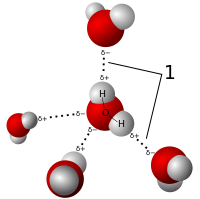
Photo from wikipedia
A drift-diffusion model for charge transport in an organic bulk heterojunction solar cell, formed by conjoined acceptor and donor materials sandwiched between two electrodes, is formulated. The model accounts for… Click to show full abstract
A drift-diffusion model for charge transport in an organic bulk heterojunction solar cell, formed by conjoined acceptor and donor materials sandwiched between two electrodes, is formulated. The model accounts for (i) bulk photogeneration of excitons, (ii) exciton drift and recombination, (iii) exciton dissociation (into polarons) on the acceptor–donor interface, (iv) polaron recombination, (v) polaron dissociation into a free electron (in the acceptor) and a hole (in the donor), (vi) electron/hole transport and (vii) electron–hole recombination on the acceptor–donor interface. A finite element method is employed to solve the model in a cell with a highly convoluted acceptor/donor interface. The solutions show that, with physically realistic parameters, and in the power generating regime, the solution varies little on the scale of the micro-structure. This motivates us to homogenise over the micro-structure; a process that yields a far simpler one-dimensional effective medium model on the cell scale. The comparison between the solution of the full model and the effective medium (homogenised) model is very favourable for applied voltages less than the built-in voltage (the power generating regime) but breaks down as the applied voltages increases above it. Furthermore, it is noted that the homogenisation technique provides a systematic way to relate effective medium modelling of bulk heterojunctions [19, 25, 36, 37, 42, 59] to a more fundamental approach that explicitly models the full micro-structure [8, 38, 39, 58] and that it allows the parameters in the effective medium model to be derived in terms of the geometry of the micro-structure. Finally, the effective medium model is used to investigate the effects of modifying the micro-structure geometry, of a device with an interdigitated acceptor/donor interface, on its current–voltage curve.
Journal Title: European Journal of Applied Mathematics
Year Published: 2017
Link to full text (if available)
Share on Social Media: Sign Up to like & get
recommendations!